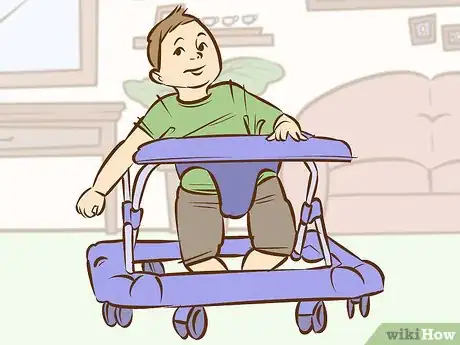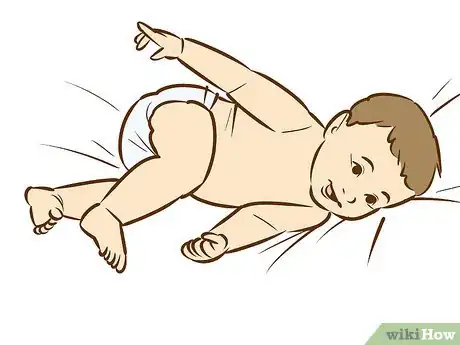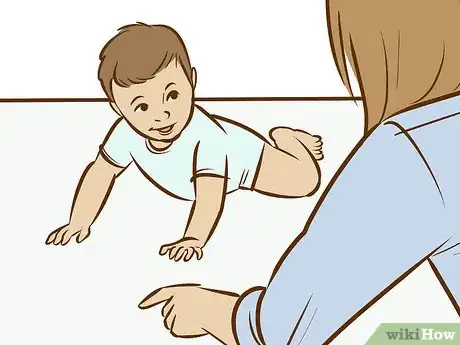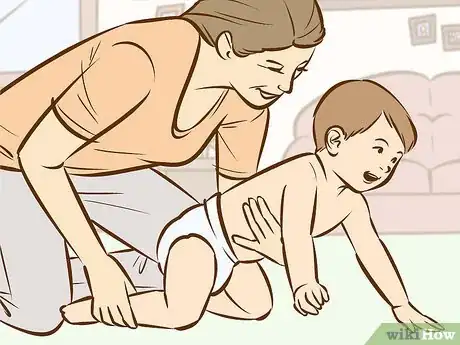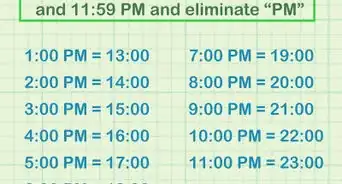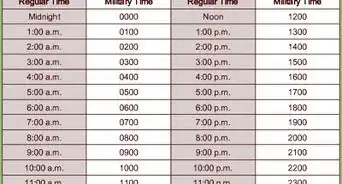This article was co-authored by Jessie Davidson. Jessie Davidson is a Child Care Specialist and the CEO and Founder of BabysitPro, which provides online courses for current and aspiring babysitters. Jessie has over 20 years of childcare experience and specializes in best practices for sitters of infants, toddlers, preschoolers, and grade-schoolers. BabysitPro’s courses are unique and age-specific so babysitters can learn detailed information relevant to the children they babysit. Jessie holds a BA in French Studies from Wheaton College and an MA in Visual Anthropology from The University of Southern California.
There are 13 references cited in this article, which can be found at the bottom of the page.
wikiHow marks an article as reader-approved once it receives enough positive feedback. In this case, 94% of readers who voted found the article helpful, earning it our reader-approved status.
This article has been viewed 605,951 times.
Most babies learn to crawl between 6 months and 10 months of age. However, if your baby is older than that and hasn't begun to crawl yet, there's no need to worry. Some babies who are heavier learn to crawl later because they have more trouble supporting their bodies, while some other babies skip the crawling phase entirely and move on straight to walking.[1] But if you do want to teach your baby to crawl, you have to make sure he's ready, and shows signs like being able to support his head, roll over, and even sit. If you want to know how to teach your baby to crawl, see Step 1 to get started.
Steps
Getting Your Baby Ready
-
1Give your baby lots of tummy time. Babies love playing on their tummies, and putting them on their tummies and letting them explore the ground and their bodies is essential to helping them develop their motor skills and head control, as well as the muscles in their arms and neck. You can start tummy time with your baby as soon as you can, allowing for just a minute or two of tummy time at first, which may not be comfortable for the baby. When your baby is just entering the world, he'll find tummy time uncomfortable because he won't feel much control over his body. However, giving him just a few minutes of tummy time a day from the start can help him develop -- and to learn to crawl at a faster pace.[2]
- As your baby gets older, around 4 months, he may be able to lift and support his head, and to look around and gain more control over his body.[3] This will mean he's on the way to learning to crawl.
- Make tummy time fun for your baby. Talk to him in a soothing way, let him play with toys, and even get down to your baby's level so he feels more comfortable on his tummy, too.[4]
- Of course, when you put your baby down to rest, you should always put your baby down on his back, so he does not end up injuring himself, or in the worst cases, suffocating.[5] But when he's up and in a good mood, tummy time can be very beneficial.
- Make sure your baby has good associations with tummy time. Put him down on his tummy after he's fed and well rested and in a good mood. You don't want him to start tummy time when he's already cranky.
-
2Limit the time your baby spends in walkers, car seats, or high chairs. Though it's important for your baby to sit some of the time, you should make sure your baby is as stimulated during his waking time as possible. Contrary to their name, walkers can actually make a baby walk less quickly because he won't feel the urge to do it on his own. If you and baby are hanging out, put the baby on his tummy or just encourage movement instead of putting him in a chair and having him stare at a mobile or a toy for hours.[6]
- The more movement your baby can do without getting tired, the better. You want to encourage your baby's motion as much as you can, so he will be ready to crawl and walk when the time comes.
Advertisement -
3Help your baby develop strength in his back. Before your baby can sit up on his own, he'll need your help. If your baby tries to sit up, make sure you use your hand to support his back and head so that your baby's head doesn't get wobbly and so your baby stays upright. This will help your baby develop the muscles he'll need to hold his head up while crawling.
- The more tummy time your baby has, the sooner he'll be able to sit.
- You can also encourage your baby to look up by waving colorful toys above his head. This will help your baby strengthen his back, neck, and shoulder muscles.
- Once your baby can lunge forward and balance on his arms, he may be ready to crawl.
-
4Make sure your baby is ready to crawl. You don't want to force your baby to crawl before he's ready, because this can lead him to get hurt or just to feel discouraged by a process that he's not ready for. Instead of comparing your baby to other babies, just focus on letting your baby develop at his own pace. Babies are ready to crawl after they are able to easily sit up without support, and when they can move their heads around and have control over their arms and legs instead of flailing them. Baby should also be able to roll over. If your baby is showing these signs, then he may not be far from crawling.
- Once your baby is able to sit up, he'll get more comfortable with the idea of moving onto all fours while being able to keep his head up, and to see that moving around, or just rocking, isn't so bad.[7]
- Your baby may already even be at the point where he's on all fours and gently rocks back and forth, trying to go forward. This is a sign that he is nearly ready to crawl!
- If your baby is moving his or her legs equally on both sides and has strong coordination, then you shouldn't worry if you've reached the 10 month mark and if it's a no go. If you have other concerns about your baby's development, then of course you should see a doctor.
- Some babies show that they're ready to crawl when they begin cross-crawling. This is when the baby uses an opposite arm and a leg to move forward instead of moving forward with the same side of the body. There are many different ways for a baby to start crawling so don't worry about having your baby do everything the way you expect it to be done.[8]
-
5Consider your baby's age. If your baby is 6 months or older, then he or she may be ready to start crawling. Just keep in mind that the range for crawling is, on average, between 6 months and 10 months, though many babies begin to crawl earlier, or even much later, than that. If your baby is just three months old, however, then you probably shouldn't try to get him to crawl unless he's showing signs of being ready, such as supporting his head, rolling over, dragging himself across the floor, etc. [9]
-
6Find a comfortable place. Your baby should learn how to crawl in a place that is comfortable and soft, but not so soft and comfortable that it is difficult for your baby to move. A blanket placed over an ordinary carpet or just a comfortable carpet will do just fine. If you have hardwood floors, you should place a nice, soft blanket over the floors. This will make your baby more comfortable and will minimize the chances of injury if your baby comes down on the floor suddenly.
- Some parents also recommend that you put your baby on the ground in a onesie or a diaper, so that he or she can make direct contact with the ground. This will give your baby a stronger connection with the ground. Putting too much clothing on your baby can also lead him to feel restricted.
- Make sure you have some lights on that are fairly bright. If the room is too dim, your baby is more likely to get drowsy.
-
7Carefully place your baby on the floor on his or her back. Look at your baby when you do this so you feel more connected. This can get your baby used to the floor and can reassure him that you're there. Make sure it's been at least 10-15 minutes since your baby has eaten so he's had some time to digest his food. He should be feeling calm and happy when you place him on the floor.
-
8Move your baby on his tummy. If your baby is comfortable with rolling over, then he can do this himself. You may need to give him some help, and move him on his tummy. He should be able to support his head with his hands, and to comfortably move his head when it's up. He should have control over his arms and legs when he gets into this position. If he cries or looks really uncomfortable, you should try another time. But if he looks ready for more, then see some of the techniques in the next section for helping him crawl forward.[10]
Getting Your Baby to Crawl
-
1Place your baby's favorite toy just out of his reach. You can talk to your baby and encourage him to get the toy, or say something like, "Come on, come get your toy..." to help your baby move forward. Your baby should start rocking back and forth, should start scooting his body toward the toy, or should just start to move closer to the object. Just make sure that this doesn't frustrate your baby or make him angry that he doesn't have his toy.[11]
-
2Have your baby crawl toward you. You can also walk a few inches away from baby, go down to baby's level, and say, "Come here! Come to mommy/daddy!" Again, if they get frustrated, go to them so that they won't cry. This can help your baby want to move toward you, and to see that crawling and getting down on all fours isn't so scary. He may want to mirror you and to get closer to you, and this is another great way to motivate your baby to move forward.
- When they start moving (but not crawling) hold their torso up as they move around.
-
3Place a mirror in front of the baby. Hold or position a mirror about 10 inches (25.4 cm) in front of your baby in a position where baby can easily see his or her reflection. Baby will want to have a better, closer view of him/herself, and may try to crawl forward to do so. If you get your baby used to playing with mirrors in general, this may be even more effective.[12]
-
4Crawl beside your baby. Instead of having your baby crawl toward you, you can also crawl alongside your baby. You and your baby can both move toward the toy, the mirror, or another parent. This will encourage your baby to do what you're doing and will make him feel less alone. He'll feel more like he's playing a gaz me and that he wants to do what mommy and daddy, or a sibling, are doing.[13]
- Having an older sibling crawl next to your baby can also encourage your baby to crawl forward.
-
5Know your baby's limits. When baby start crying or seems to be getting frustrated, don't force him to keep trying. Instead, wait until the next day to try again. If you try to force your baby to crawl when he's not ready or just not feeling it, then you'll delay the process and make your baby associate crawling with having a bad time. Instead, your baby should look at crawling as a fun, empowering activity.
- Don't give up. Even if baby can only tolerate being on the floor for a few seconds at a time, try again later or the next day.
-
6Encourage your baby after crawling time is over. Once you're done with teaching your baby to crawl for the day, make sure you give your baby lots of love and encouragement. Don't get frustrated if your baby doesn't get very far. Instead, give your baby lots of physical love and attention, a warm bottle if he needs one, a toy, or a treat if he's old enough to eat them. Your baby should have positive associations with crawling time and should feel excited to come back for more.
- It goes without saying that, if your baby was crawling toward a toy, you should give it to him at the end of the exercise, even if he wasn't able to reach it himself. He should feel satisfied, not frustrated, about learning to crawl. This will make your baby even more excited about trying to crawl the next time around!
- Once your baby is able to crawl and explore your home, then you can celebrate! And then, get ready to babyproof your house!
Expert Q&A
-
QuestionWhen do babies start walking without help?
 Jessie DavidsonJessie Davidson is a Child Care Specialist and the CEO and Founder of BabysitPro, which provides online courses for current and aspiring babysitters. Jessie has over 20 years of childcare experience and specializes in best practices for sitters of infants, toddlers, preschoolers, and grade-schoolers. BabysitPro’s courses are unique and age-specific so babysitters can learn detailed information relevant to the children they babysit. Jessie holds a BA in French Studies from Wheaton College and an MA in Visual Anthropology from The University of Southern California.
Jessie DavidsonJessie Davidson is a Child Care Specialist and the CEO and Founder of BabysitPro, which provides online courses for current and aspiring babysitters. Jessie has over 20 years of childcare experience and specializes in best practices for sitters of infants, toddlers, preschoolers, and grade-schoolers. BabysitPro’s courses are unique and age-specific so babysitters can learn detailed information relevant to the children they babysit. Jessie holds a BA in French Studies from Wheaton College and an MA in Visual Anthropology from The University of Southern California.
Child Care Specialist It is common for babies to start walking unassisted at around 12 months old. However, this milestone can happen anytime between around 9 and 17 months. The baby will show many signs that they are strong enough to walk by themselves, like pulling themselves up on furniture, squatting down to pick up a toy and stand up again, or walking about with their hands on furniture as a support. If they can pull themselves up with ease to stand and like to scoot around the furniture, it's possible they may be ready to walk without your support.
It is common for babies to start walking unassisted at around 12 months old. However, this milestone can happen anytime between around 9 and 17 months. The baby will show many signs that they are strong enough to walk by themselves, like pulling themselves up on furniture, squatting down to pick up a toy and stand up again, or walking about with their hands on furniture as a support. If they can pull themselves up with ease to stand and like to scoot around the furniture, it's possible they may be ready to walk without your support. -
QuestionIs it all right that my four month old baby is not rolling yet?
 Community AnswerIt is completely normal, as many babies are not yet rolling by four months old. Provide your baby with tummy time for opportunities to learn, and consult your doctor if you are still worried.
Community AnswerIt is completely normal, as many babies are not yet rolling by four months old. Provide your baby with tummy time for opportunities to learn, and consult your doctor if you are still worried. -
QuestionIs it okay to let my baby play and then put them back on their tummy after a few hours?
 Community AnswerYes, it is okay. Make sure the baby is in a good mood before doing so. If your baby has eaten, wait for 25-30 minutes before placing on it on it's tummy.
Community AnswerYes, it is okay. Make sure the baby is in a good mood before doing so. If your baby has eaten, wait for 25-30 minutes before placing on it on it's tummy.
Warnings
- It's also a good idea to childproof your baby's room and any other room your baby has access to before teaching them to crawl.⧼thumbs_response⧽
Things You'll Need
- a soft, large, and thick rug or blanket
- a small mirror (optional)
- one of baby's favourite toys
References
- ↑ https://www.parents.com/baby/development/crawling/when-do-babies-crawl/
- ↑ http://www.babycenter.com/0_tummy-time-how-to-help-your-baby-get-comfortable-on-his-bell_1439985.bc
- ↑ https://www.babycentre.co.uk/a6579/developmental-milestones-head-control
- ↑ https://www.zerotothree.org/resources/202-steps-toward-crawling
- ↑ https://www.healthychildren.org/English/ages-stages/baby/sleep/Pages/A-Parents-Guide-to-Safe-Sleep.aspx
- ↑ https://www.nhs.uk/conditions/pregnancy-and-baby/keeping-kids-active/
- ↑ https://www.thebump.com/a/when-do-babies-crawl
- ↑ https://www.babycenter.com/0_baby-milestone-crawling_6501.bc
- ↑ https://www.parents.com/baby/development/crawling/when-do-babies-crawl/
- ↑ https://www.mustelausa.com/baby-crawling
- ↑ https://www.babycenter.com/0_baby-milestone-crawling_6501.bc
- ↑ https://www.mustelausa.com/baby-crawling
- ↑ https://www.mustelausa.com/baby-crawling
- http://www.babycenter.com/0_developmental-milestones-crawling_6501.bc
- https://www.youtube.com/watch?v=M5kqlnmdvsE
- http://www.zerotothree.org/child-development/early-development/crawling.html
About This Article
While most babies learn to crawl on their own, and others skip straight to walking, if you want to try to encourage your baby to crawl, place your baby on their tummy on the floor. Set their favorite toy just out of their reach, and encourage them to reach for the toy in a positive, enthusiastic tone. You could also sit or lie down on the floor and call your child to you. However, if your baby starts to get frustrated or discouraged, go to them or give them their toy so they don’t start to cry, then try again later. Keep reading to learn some of the signs your baby is ready to crawl, such as being able to sit on their own.

